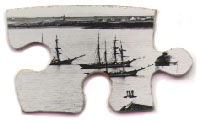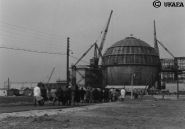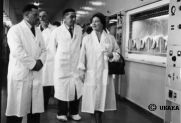



Highland Archives
Sponsored by ![]()
Dounreay - Open For Public Inspection
The world woke up on Saturday, May 11th, 1957, to news that the USSR was calling on Britain and the United States to stop testing atomic weapons, and so help avoid a nuclear war with all its dire consequences.'Those who are opposed to the cessation of tests are for war,' the Soviet Foreign Minister solemnly declared. War, however, was far from the minds of the people of the North of Scotland on that fine May morning - they were for Dounreay. It was the United Kingdom Atomic Energy Authority's first site Open Day.
 |
| Visitors on the first site open day |
 |
| HRH the Queen Mother on a site visit |
Since early construction days Dounreay had been a 'must-see' for visitors to the North coast. Everyone who was Anyone - and a fair few who thought they were, but weren't - wanted to see just what was going on at this lonely seaside site beside the Atlantic ocean.
For example: in late October 1955, Lady Collins passed by on her way to Thurso, come fresh from a spot of fishing in the Naver. It was evening, dusk had already turned to darkness, but work on the great steel containment sphere for the fast reactor was still going on. Bathed in artificial light the squads of steelfixers and welders could be clearly seen, hard at work, the staccato rat-a-tat-tat of hammers rising above the steady non-stop hum of electricity generators, the bright-white flashes of welding torches piercing the gloom. It was an eerie, surreal sight, an appealing vision for a romantic soul like Lady Collins. Fascinated, she drove down the runway to the site main gate where her progress was arrested by a burly policeman who informed her, politely, that as no one was available at this late hour to authorise her entry to the site, Lady Collins would have to be content with gazing at this nuclear wonderland from outside the security fence. The Lady's protests were all in vain the Queen of England herself could not pass through the Dounreay security gate without the requisite authority. And that was that. Exasperated, no doubt, Lady Collins departed post haste for Thurso, leaving behind a message for Donald Carmichael, Dounreay's Chief Administration Officer, that she could be contacted next day at the Royal Hotel. When Mr Carmichael arrived at the hotel he was too late: Lady Collins had already gone. But she was kind enough to leave him a jar of honey and a charmingly worded note. Ever the diplomat, Carmichael wrote Lady Collins an apologetic letter regretting his lack of foresight in not being on site when she arrived, thanking her for the delicious honey, which his little daughter had really enjoyed, and begging her to be sure to let him know next time she was coming North. He closed this letter with a postscript recommending the type of salmon flies best suited to the Naver.
In the summer of 1956 an expensive looking car drew up at the Dounreay security gate. The driver introduced himself to the duty policeman whose hasty phone call brought an individual of distinguished appearance hurrying to the gate to meet the newcomers. A slim, aristocratic man and two elegant ladies, one decked out in a shocking pink chiffon dress and wide-brimmed straw sun hat introduced themselves to General Joslin, Dounreay's Works General Manager. The Duke and Duchess of Sutherland and their dear friend Barbara Cartland, wished to look the site over. All of it. There and then.
And so the thousand or more men toiling at Dounreay on that warm afternoon, were distracted by a mirage in pink chiffon which made its regal way all around the site, its dignity uncompromised even when travelling skyward in the rickety open cage lift that carried the Duke's party 70 feet above the base of the fast reactor, or daintily tripping along the scaffold planks from which the visitors looked down on the great concrete biological shield designed to contain the reactor vessel. Unaware of their guests' identities, the workmen welcomed them with a barrage of whistles and wolf calls. They were not disappointed: the ladies responded with cheerful waves, a perfect example of genuine good breeding.
The seven thousand Far North residents who arrived at Dounreay by bus and private car on May 11th, 1957 brought with them a more serious purpose than aristocratic sightseeing. They had come to see what so much time, money and social upheaval had given birth to. Many were keen to inspect what might soon.become their new workplace, the UKAEA having advertised locally for Process Workers, Monitors, Tradesman's Mates and Labourers. Strangers to Dounreay the Open Day visitors might have been, but they could hardly plead ignorance of atomic energy.
As part of its Public Relations strategy the UKAEA had sought to inform the Caithness public about all aspects of its work at Dounreay. Following on from Sir Christopher Hinton's ground-breaking lectures at Thurso Town Hall in January 1955, the Authority had hosted a number of exhibitions and talks designed to acquaint the lay public with the peaceful application of atomic energy. The thrust of all this publicity was to assure people that Dounreay was not going to evaporate in a giant mushroom cloud, nor did the site have any connection with the manufacture of atomic bombs.
In April 1955, Mr K.B. Ross, the UKAEA's Director of Operations, opened an atomic energy exhibition in Thurso Town Hall. This exhibition took three months to prepare, went on for a week and was well attended. In addition to scale models of the Dounreay site and the UKAEA's proposed Thurso housing scheme, there were hands-on demonstrations of nuclear instrumentation such as geiger counters, and a section emphasising the advantages of signing on as Dounreay engineering apprentice.
The following year, 1956, lectures on atomic energy and the Dounreay project were given in both Wick and Thurso by General Joslin and his deputy, Arthur Parry. Again these talks were well received by a public whose appetite for news and information about Dounreay, however insignificant, appeared to be insatiable. In the week immediately prior to the Official Site Open Day, the Authority judged it politically wise to refresh the public appetite by staging further exhibitions both in Caithness and further afield in Inverness and Aberdeen. In addition to all this, the UKAEA announced that Friday, 10th May would be Press Day.
From all over they came. From Holland, Poland, China, Germany, Belgium, Japan, the USA, Russia, Sweden; reporters, newspaper correspondents, radio reviewers, technical authors. Ten at a time they were conducted round the Dounreay site by UKAEA officials. A lengthy journey and a tiring one, culminating in a Press conference presided over by Sir Christopher Hinton himself, assisted by General Joslin, Works General Manager, T.G. Williams, the brilliant Welsh civil engineer who oversaw the construction of Dounreay, and Charles Tottle who, in December 1955, at the tender age of 34, had been appointed Head of Laboratories. A formidable panel; but their wits were to be well tested by the gentlemen of the press.
The record of the Press Conference which took place at Dounreay 41 years ago is both interesting and instructive. Safety was a prime topic, especially the consequences of a core meltdown in the Dounreay fast reactor. Hinton dealt with this by repeating what he had told the Caithness public 2 years before; that the dome was designed to cope with any eventuality, the most serious postulated accident being a core meltdown accompanied by a sodium fire. Both the combustion and nuclear fission products of such an accident would be contained within the reactor sphere.
The economics of nuclear power were also called into question, cost comparisons being requested between Britain's favoured reactor types - the Dounreay fast breeder and the gas cooled thermal reactor, then in its first year of operation at Calder Hall - and the new Pressurised Water Reactor being built in the USA. Time would tell, was Hinton's answer, but he was not in a position to give opinions on what another country was doing, and in any case, in addition to ample supplies of the enriched uranium fuel needed for reactors of the pressurised water type, the Americans also used a different method of accounting their nuclear expenditure, As far as fast breeders went, their prime purpose was not to produce cheaper electricity, but to burn the plutonium produced by thermal reactors.
Great interest was expressed in the reactor to be built at Dounreay in support of the Navy's nuclear submarine programme. The news of this development had recently been made public but, for obvious security reasons, details were vague to say the least. Sir Christopher gave nothing away; the UKAEA were only responsible for the civil engineering work on the navy site. He did however reveal that consideration was being given to designing high-powered reactors small enough to fit into surface ships. Experimental work associated with this idea was planned for the Dounreay Materials Testing Reactor which, along with the fast reactor, was scheduled to start active work in April 1958.
There were other questions of a general nature about the Dounreay project. These were, for the most part, fully addressed; but it is worth remarking that not one of the panel's replies gave rise to further persistent interrogation, nor was Christopher Hinton asked for an explanation if he refused to answer a question. Perhaps the media conformed to politer standards in those days, or maybe the fact that Sir Christopher Hinton was 6 foot 5 inches tall and had a somewhat overbearing manner, was itself sufficient discouragement.
In view of later Government decisions relating to the Fast Reactor, a statement made by General Joslin is revealing. The General said that the Dounreay project was in no way connected with the UKAEA's commercial activities. The sale of electricity, the production of plutonium or radio-isotopes; these things were unimportant. The objective of the proposed work at Dounreay was to provide a research and development framework within which a programme of experiments could be undertaken. When, or even if, the fast reactor exported electricity to the National Grid: was of secondary importance.
Next day it was the publics turn. They didn't get a question-and-answer session with Sir Christopher Hinton, who had left for a fishing holiday in Orkney, but they saw sights enough to satisfy anyone's scientific curiosity. There were queues when the gates opened at 10 a.m.; folk had travelled from Inverness, Orkney and all quarters of Caithness and Sutherland, come for a peek at the space-fiction creations science had raised in a place where previously sheep had grazed, accompanied by the piping cries of oystercatchers and the curlew's mournful call.
All day long UKAEA white-coated technicians escorted parties of visitors around the site. The first port of call was the chemical group, a complex of laboratories, fuel element fabrication plants, spent fuel reprocessing facilities and stores for highly radioactive waste. On either side of a 440 foot long corridor were suites of laboratories, specially designed for analysing all kinds of radioactive substances. These laboratories had cost £700k to build and equipped. Some of them contained thickly walled cells wherein highly radioactive substances were to be handled by remote control, using robot arms known as 'master slave' manipulators. UKAEA staff demonstrated the skill and delicacy with which these manipulators could be used to transfer liquid from one glass container to another. Visitors were invited to try their hand - many doing so, delighted when they succeeded in mastering the tricky art, sharing in the general mirth when their efforts ended in spilled liquid or broken glass.
In other laboratories guests were introduced to a bewildering array of gadgets; spectrometers, chromatographs, ion chambers, and mixer-settler boxes in which coloured liquids sloshed about, demonstrating the chemistry of separating valuable uranium from the residues of spent reactor fuel. At the far end of the chemical complex was the plant where highly active liquid wastes were to be refined and stored in subterranean tanks. This building, D1208, had cost £650k. A rare selection of masterpieces were on show here, for this was the building where Thomas Ward's pipefitters had produced their finest work. Pipes everywhere; each one arrayed in perfect symmetry with its neighbours and, startling but true, all this tubular poetry was destined to be sealed away from human eyes once the plant began operations.
The Materials Testing Reactor was next on the itinerary, a quart in a pint pot, filled with pipes, cables, ducts and nucleonic instruments. Parties of visitors trooped diligently round the narrow walkway that surrounded the reactor, trying to take in everything their technician guides told them about this exciting new scientific development, which was to be used to unlock the innermost secrets of materials which might prove useful to medicine, industry and, of course, nuclear power reactors. The bill for this experimental tool was £1.3M.
Then there was the Health & Safety block which included a fully-equipped fire station, a control centre for site emergencies, and laboratories where samples of seaweed, soil, grass, milk and human waste products could be checked for abnormal levels of radioactivity. Doubtless most of this was foreign territory to a population brought up on agriculture and fishing; but many of those who came to Dounreay on that first Open Day would soon find themselves fully conversant with the terminology of nuclear physics. Indeed, within a short space of time some of them would be instructing newcomers about Contamination Control, Barrier Drill and the Time & Distance method of reducing personal exposure to ionising radiation.
Naturally, the attraction everyone wanted to see was the Fast Reactor and the great sphere that contained it. This giant vessel had just been completed. Above it flew the Scottish Saltire, a fitting tribute to the Lanarkshire firms, Motherwell Bridge and Findlays, who had built it. 600 tons of steel, 7000 tons of reinforced concrete, £5.5M of public money. Powerful statistics at a time when the most skilled tradesman was paid £10 for a basic week. And there was no guarantee that the technology would work for, prior to DFR no one had ever built a power producing fast reactor, no one had any experience of using liquid metals in large quantities, and the only experimental knowledge about fast reactors had come from small scale test rigs. The theory that underpinned this expensive engineering was based largely on scientific intuition and predictions extrapolated from previous nuclear work. To design and build such a complex machine as the Dounreay Fast Reactor was truly an act of faith. But the thing worked and the rest is history.
Dounreay has had another Open Day this month (July 1998). Things have moved on since the first one, 41 years ago. Fast reactors are no longer new, in fact some regard them as a scientific anachronism, an expensive blind alley whose exploration squandered vast amounts of valuable intellectual and financial resources. And all for what? You might well ask. The future, however, is an unwritten page and to have in hand the accumulated knowledge of four decades of practical experience of fast reactor technology is surely no mean asset.
Operational fast reactors are no longer with us, but this is not to say that Dounreay is a dead duck. On the contrary, much of its mission remains unfulfilled. Not one of its three reactors has been fully decommissioned; many plants in the fuel cycle area are still operational; improved methods are continually being applied to the handing and storage of radioactive waste; and there is, of course, the small task of emptying the waste shaft and the silo ...
The site is well worth a visit, even for the most committed opponent of nuclear technology.
The above article was based largely on documents from the personal archive of Donald Carmichael, Dounreay's first permanent employee. I am grateful to Margaret Carmichael for giving me the opportunity of consulting her late husband's papers.
Steven Cashmore 1998
![]()
Information contained on this page may only be used for personal use,any request for
full or part publication must be carried out through the Highland archive.
Send information for these archives to william@caithnessarchives.org.uk